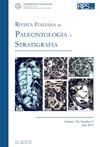中新世晚期-上新世早期地中海虾虎鱼的演化及其环境和生物地理意义
IF 1.9
3区 地球科学
Q2 GEOLOGY
引用次数: 16
摘要
地中海墨西尼亚盐度危机(MSC)结束时的Lago Mare阶段长期以来以其生物群的准特提斯亲缘关系而闻名。然而,这些亲缘关系的分类学水平及其起源有不同的解释。在这里,我们研究了意大利和希腊中新世晚期和上新世早期Gobioidei矿床的耳石,并修订了早期研究,包括罗马尼亚和土耳其西北部的时间等效数据。如今,虾虎鱼是欧洲种类最多的海鱼科,也是蓬托-里海地区种类最多的特有鱼类科。此外,它们高度适应近岸浅海、半咸水和淡水环境,这使它们成为探索不同性质水道短期连接的绝佳候选者。所研究的意大利和希腊地区的正常海洋-晚托托阶和前蒸发期-墨西阶沉积物包含丰富多样的虾虎鱼群落,但具有准特提斯亲缘关系的物种非常罕见,可能起源于塞拉瓦利亚早期(巴登尼亚晚期)和墨西阶早期(梅奥蒂亚早期)的连接。卡拉布里亚Cessanti的一种罕见的近海环境动物群,与现在几内亚沿海地区发现的红树林环境相似,揭示了Eleotridae科的两个物种,没有与Paratethyan有亲缘关系的虾虎鱼。Cessaniti提供了一个独特的机会,通过欧洲新近纪独特的类虾虎鱼组合来认识这种环境背景的存在。MSC正下方Strada degli Archi的浅水微咸水影响沉积物显示出副特提斯虾虎鱼类群(Proterorinus yigitbasi,Zosterisessor exsul n.sp.)的影响越来越大,它们不存在于时间等效的正常海洋环境中,但也在罗马尼亚达契奇盆地中被发现。MSC第3阶段的沉积物,特别是在Lago Mare事件期间积累的沉积物,主要由具有副特提斯亲缘关系的多样化虾虎鱼组合所主导,而地中海本地虾虎鱼类群的消失可能是因为缺乏适合浅海底层狭盐鱼类的条件,除了nektonic Aphia minuta。MSC第3阶段的沉积物也包括在一个特定的位置和水平面上的不寻常的Enigmacottus social n.gen.,n.sp.,它是来源不确定的Psychrolutidae家族的一个假定成员,约占意大利该区间获得的所有耳石的70%。从赞clean开始,地中海的虾虎鱼群落几乎完全由大西洋-地中海组成。共有15个新物种被描述,其中12个属于食蚊科,两个属于Eleotridae,一个被认为是Psychrolutidae。新分类群为:Eleotris omuamuaensis n.sp.,Eleotris tyrrhenicus n.sp.、Lesueurigobius stazzanensis n.sp、Gobius peloponnesus n.sp..、Proterohinus cretensis n.sp。,Hesperichthys gironeae n.sp.、Knipowitchia etrusca n.sp.和Enigmacottus social n.gen.et n.sp。本文章由计算机程序翻译,如有差异,请以英文原文为准。
Late Miocene-Early Pliocene evolution of Mediterranean gobies and their environmental and biogeographic significance
The Lago Mare phase at the end of the Messinian Salinity Crisis (MSC) in the Mediterranean has long been known for the Paratethyan affinities of its biota. The taxonomic level of these affinities and their origin, however, is subject to divergent interpretations. Here, we have studied otoliths of the Gobioidei from late Miocene and early Pliocene deposits from Italy and Greece and revised earlier studies including time-equivalent data from Romania and NW Turkey. Nowadays, gobies constitute the most speciose marine fish family in Europe and the most diverse endemic family in the Ponto-Caspian region. Furthermore, they are highly adapted to nearshore shallow marine, brackish, and freshwater environments, which makes them excellent candidates to explore short-term connections of waterways of different nature.
The normal marine late Tortonian and pre-evaporitic Messinian deposits of the studied Italian and Greek locations contained a rich and diverse goby assamblage, but species with Paratethyan affinities were very rare and possibly originated from connections during the early Serravallian (late Badenian) and early Messinian (early Meotian). A rare fauna from a paralic environment from Cessaniti, Calabria, similar to the mangrove environments found in the present-day Guinea coastal area, revealed two species of the family Eleotridae and no gobies with Paratethyan affinities. Cessaniti provides a unique opportunity to recognize the presence of this type of environmental context with a unique gobioid assemblage in the Neogene of Europe. The shallow-water brackish-influenced sediments of Strada degli Archi just below the MSC show an increasing influence of Paratethyan gobiid taxa (Proterorhinus yigitbasi, Zosterisessor exsul n. sp.), which are not present in time-equivalent normal marine environments, but have also been identified in the Dacic Basin of Romania. Sediments of the stage 3 ot the MSC, especially those that accumulated during the Lago Mare event, were dominated by a diverse goby assemblage with Paratethyan affinities, while indigenous Mediterranean goby taxa disappeared probably because of the lack of suitable conditions for neritic demersal stenohaline fishes, except for the nektonic Aphia minuta. The sediments of the stage 3 of the MSC also included in one particular location and level the unusual Enigmacottus socialis n. gen., n. sp., a putative member of the family Psychrolutidae of uncertain origin, which constitutes about 70% of all otoliths obtained from that interval in Italy. Beginning with the Zanclean, the goby assemblage of the Mediterranean shows an almost exclusively Atlantic-Mediterranean composition.
A total of 15 new species are described, 12 in the family Gobiidae, two of the Eleotridae, and one putative Psychrolutidae. The new taxa are: Eleotris omuamuaensis n. sp., Eleotris tyrrhenicus n. sp., Lesueurigobius stazzanensis n. sp., Gobius peloponnesus n. sp., Proterorhinus cretensis n. sp., Zosterisessor exsul n. sp., Benthophilus aprutinus n. sp., Benthophilus labronicus n. sp., Caspiosoma lini n. sp., Caspiosoma paulisulcata n. sp., Thorogobius petilus n. sp., Buenia pisiformis n. sp., Hesperichthys gironeae n. sp., Knipowitschia etrusca n. sp., and Enigmacottus socialis n. gen. et n. sp.
求助全文
通过发布文献求助,成功后即可免费获取论文全文。
去求助
来源期刊
CiteScore
3.60
自引率
4.30%
发文量
28
审稿时长
>12 weeks
期刊介绍:
The Rivista Italiana di Paleontologia e Stratigrafia was founded in 1895. It publishes original papers dealing with all fields of paleontology and of stratigraphy, from Italy and the Mediterranean to the Tethys, as well across the globe from China to North America.

 求助内容:
求助内容: 应助结果提醒方式:
应助结果提醒方式:


